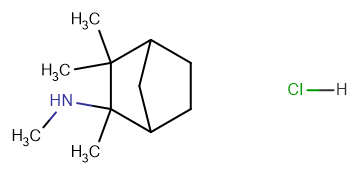
Mecamylamine hydrochloride
CAS No. 826-39-1
Mecamylamine hydrochloride ( Inversine )
Catalog No. M16067 CAS No. 826-39-1
A nicotinic antagonist that is well absorbed from the gastrointestinal tract and crosses the blood-brain barrier.
Purity : >98%(HPLC)
 COA
COA
 Datasheet
Datasheet
 HNMR
HNMR
 HPLC
HPLC
 MSDS
MSDS
 Handing Instructions
Handing Instructions
| Size | Price / USD | Stock | Quantity |
| 5MG | 27 | In Stock |


|
| 10MG | 46 | In Stock |


|
| 25MG | 110 | In Stock |


|
| 50MG | 177 | In Stock |


|
| 100MG | 267 | In Stock |


|
| 200MG | 410 | In Stock |


|
| 500MG | Get Quote | In Stock |


|
| 1G | Get Quote | In Stock |


|
Biological Information
-
Product NameMecamylamine hydrochloride
-
NoteResearch use only, not for human use.
-
Brief DescriptionA nicotinic antagonist that is well absorbed from the gastrointestinal tract and crosses the blood-brain barrier.
-
DescriptionA nicotinic antagonist that is well absorbed from the gastrointestinal tract and crosses the blood-brain barrier. Mecamylamine has been used as a ganglionic blocker in treating hypertension, but, like most ganglionic blockers, is more often used now as a research tool.
-
SynonymsInversine
-
PathwayEndocrinology/Hormones
-
TargetAChR
-
RecptornAChR
-
Research Area——
-
Indication——
Chemical Information
-
CAS Number826-39-1
-
Formula Weight203.75
-
Molecular FormulaC11H22ClN
-
Purity>98%(HPLC)
-
SolubilitySoluble in DMSO
-
SMILESCC1(C)C(NC)(C)C2CCC1C2.[H]Cl
-
Chemical NameN,2,3,3-tetramethylbicyclo[2.2.1]heptan-2-amine hydrochloride
Shipping & Storage Information
-
Storage(-20℃)
-
ShippingWith Ice Pack
-
Stability≥ 2 years
Reference
1. Struthers AM, et al. Pharmacol Biochem Behav. 2009 Dec;94(2):319-28.
molnova catalog


related products
-
G007-LK
G007-LK is a selective inhibitor of TNKS1 and TNKS2, with IC50s of 46 nM and 25 nM, respectively.
-
Pempidine
Pempidine is a ganglion-blocking drug, introduced as an oral treatment for hypertension.
-
Otilonium bromide
Otilonium bromide is an antimuscarinic.



 Cart
Cart
 sales@molnova.com
sales@molnova.com


